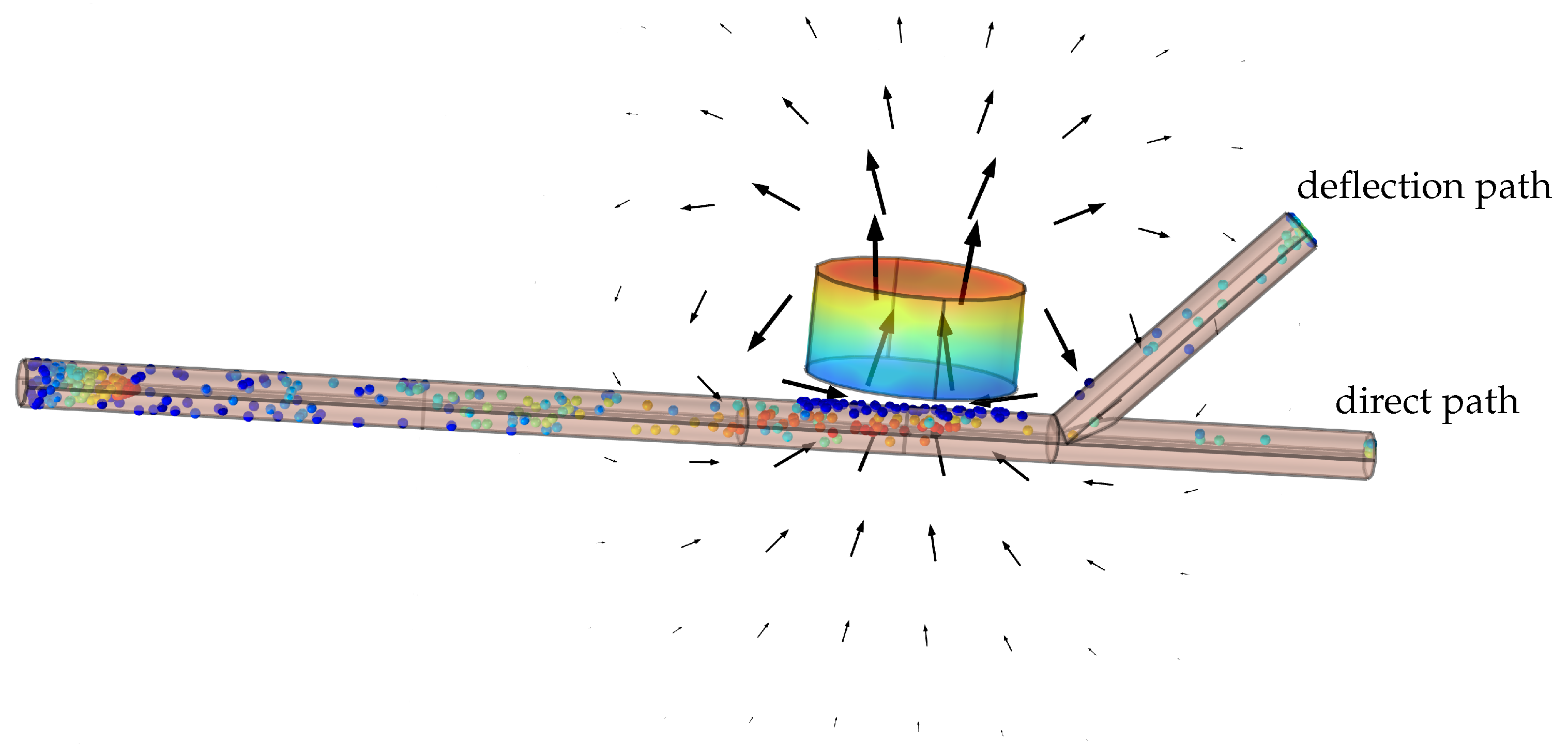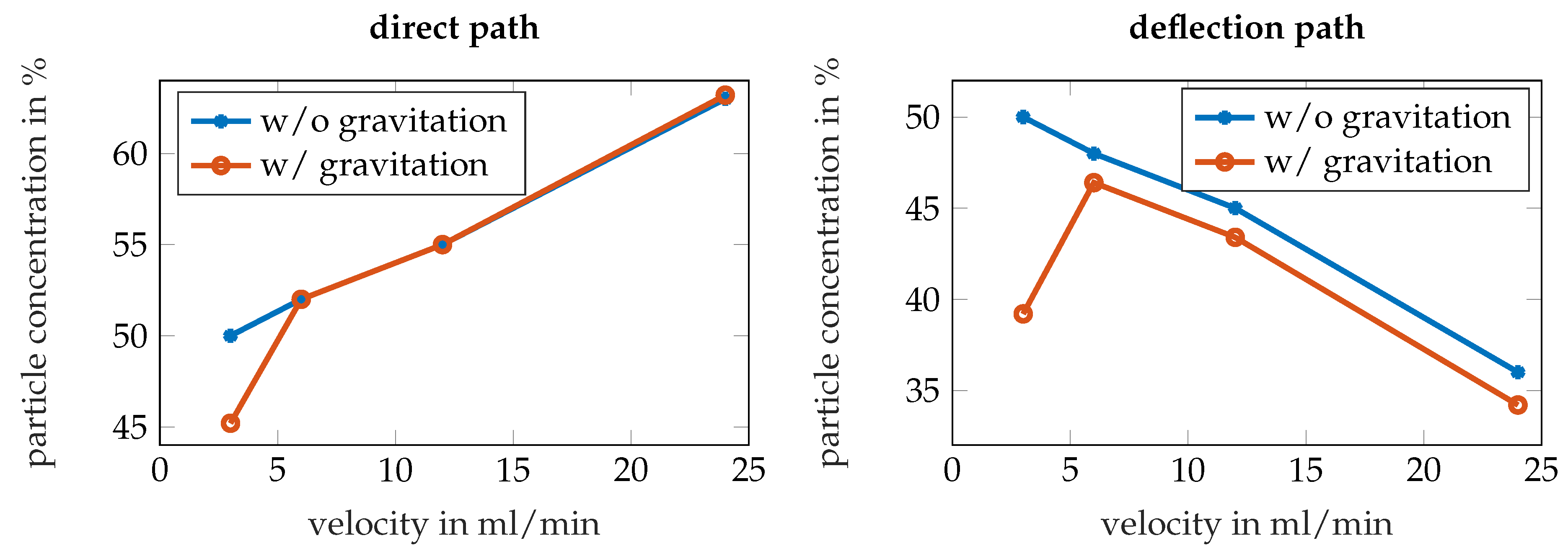Investigation of Particle Steering for Different Cylindrical Permanent Magnets in Magnetic Drug Targeting †
Abstract
:1. Introduction
2. Fundamentals
2.1. Nanoparticles
2.2. Forces
3. Materials and Methods
4. Results and Discussion
4.1. Influence of the Fluid Velocity
4.2. Influence of the Gravitational Force
4.3. Influence of the Magnet
5. Conclusions
Funding
Conflicts of Interest
References
- Pankhurst, Q.A.; Connolly, J.; Jones, S.K.; Dobson, J. Applications of magnetic nanoparticles in biomedicine. J. Phys. D Appl. Phys. 2003, 36, R167. [Google Scholar] [CrossRef]
- Tietze, R.; Lyer, S.; Dürr, S.; Struffert, T.; Engelhorn, T.; Schwarz, M.; Eckert, E.; Göen, T.; Vasylyev, S.; Peukert, W.; et al. Efficient drug-delivery using magnetic nanoparticles–biodistribution and therapeutic effects in tumour bearing rabbits. Nanomed. Nanotechnol. Biol. Med. 2013, 9, 961–971. [Google Scholar] [CrossRef] [PubMed]
- Alexiou, C.; Schmidt, A.; Klein, R.; Hulin, P.; Bergemann, C.; Arnold, W. Magnetic drug targeting: Biodistribution and dependency on magnetic field strength. J. Magn. Magn. Mater. 2002, 252, 363–366. [Google Scholar] [CrossRef]
- Hoshiar, A.K.; Le, T.A.; Amin, F.U.; Kim, M.O.; Yoon, J. Studies of aggregated nanoparticles steering during magnetic-guided drug delivery in the blood vessels. J. Magn. Magn. Mater. 2017, 427, 181–187. [Google Scholar] [CrossRef]
- Klarhöfer, M.; Csapo, M.B.; Balassy, C.; Szeles, J.; Moser, E. High–resolution blood flow velocity measurements in the human finger. Magn. Reson. Med. 2001, 45. [Google Scholar] [CrossRef] [PubMed]
- Hennig, T.L.; Unterweger, H.; Lyer, S.; Alexiou, C.; Cicha, I. Magnetic Accumulation of SPIONs under Arterial Flow Conditions: Effect of Serum and Red Blood Cells. Molecules 2019, 24, 2588. [Google Scholar] [CrossRef] [PubMed]
- Cullity, B.D.; Graham, C.D. Introduction to Magnetic Materials; John Wiley & Sons, Inc.: Hoboken, NJ, USA, 2008. [Google Scholar] [CrossRef]
- Hanini, A.; Schmitt, A.; Kacem, K.; Chau, F.; Ammar, S.; Gavard, J. Evaluation of iron oxide nanoparticle biocompatibility. Int. J. Nanomed. 2011, 6, 787–794. [Google Scholar] [CrossRef]
- Zaloga, J.; Janko, C.; Nowak, J.; Matuszak, J.; Knaup, S.; Eberbeck, D.; Tietze, R.; Unterweger, H.; Friedrich, R.P.; Duerr, S.; et al. Development of a lauric acid/albumin hybrid iron oxide nanoparticle system with improved biocompatibility. Int. J. Nanomed. 2014, 9, 4847–4866. [Google Scholar] [CrossRef] [PubMed]
- Alnaimat, F.; Dagher, S.; Mathew, B.; Hilal-Alnqbi, A.; Khashan, S. Microfluidics Based Magnetophoresis: A Review. Chem. Rec. 2018, 18, 1596–1612. [Google Scholar] [CrossRef] [PubMed]
- Furlani, E.P.; Sahoo, Y. Analytical model for the magnetic field and force in a magnetophoretic microsystem. J. Phys. D Appl. Phys. 2006, 39, 1724–1732. [Google Scholar] [CrossRef]
- Wang, J.; Hu, D.; Shetty, C.; Hassanieh, H. Understanding and embracing the complexities of the molecular communication channel in liquids. In Proceedings of the 26th Annual International Conference on Mobile Computing and Networking, London, UK, 21–25 September 2020; ACM: New York, NY, USA, 2020; pp. 1–15. [Google Scholar] [CrossRef]




| Category | Symbol | Value | Unit | Label |
|---|---|---|---|---|
| 2 | cm | radius | ||
| vessel | L | 13 | cm | length |
| 1 | 1 | relative permeability of the fluid | ||
| 350 | nm | radius | ||
| particle | 2000 | kg/m | density | |
| 4000 | 1 | relative permeability | ||
| magnet | V | 3 | cm | volume |
| A/m | saturation magnetization |
Publisher’s Note: MDPI stays neutral with regard to jurisdictional claims in published maps and institutional affiliations. |
© 2020 by the authors. Licensee MDPI, Basel, Switzerland. This article is an open access article distributed under the terms and conditions of the Creative Commons Attribution (CC BY) license (https://creativecommons.org/licenses/by/4.0/).
Share and Cite
Thalmayer, A.S.; Zeising, S.; Fischer, G.; Kirchner, J. Investigation of Particle Steering for Different Cylindrical Permanent Magnets in Magnetic Drug Targeting. Eng. Proc. 2020, 2, 24. https://doi.org/10.3390/ecsa-7-08269
Thalmayer AS, Zeising S, Fischer G, Kirchner J. Investigation of Particle Steering for Different Cylindrical Permanent Magnets in Magnetic Drug Targeting. Engineering Proceedings. 2020; 2(1):24. https://doi.org/10.3390/ecsa-7-08269
Chicago/Turabian StyleThalmayer, Angelika S., Samuel Zeising, Georg Fischer, and Jens Kirchner. 2020. "Investigation of Particle Steering for Different Cylindrical Permanent Magnets in Magnetic Drug Targeting" Engineering Proceedings 2, no. 1: 24. https://doi.org/10.3390/ecsa-7-08269
APA StyleThalmayer, A. S., Zeising, S., Fischer, G., & Kirchner, J. (2020). Investigation of Particle Steering for Different Cylindrical Permanent Magnets in Magnetic Drug Targeting. Engineering Proceedings, 2(1), 24. https://doi.org/10.3390/ecsa-7-08269







